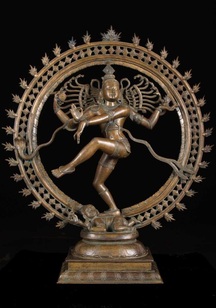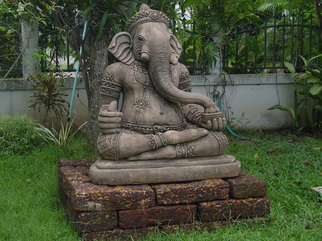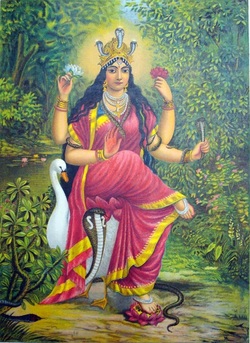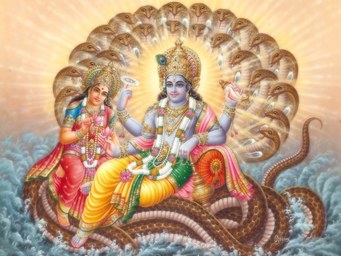| A Brief Introduction to Hinduism |
Four Major Modern Hindu Sects
Although Hinduism is difficult to divide into sects, doing so helps us understand it. The following is a brief explanation of the four most popular modern sects of Hinduism. To learn about the gods each sect worships, visit the Deities page.
Shaivism

A Shiva Nataraja
Shaivists worship Shiva, the god of destruction. For them, destruction is not a negative process; it is necessary to destroy in order to make room for the new. Shiva enables this. Shaivism has 220 million followers. It is the second-most popular sect of Hinduism, and is widespread in India, Nepal, Sri Lanka, Malaysia, Singapore, and Indonesia. To the right a Shiva Nataraja is pictured. To learn about the symbolism of this exquisite artform, click here.
Smartism

Ganesha, the God of Beginnings
Smartism is a bit different from other Hindu sects because it is not bound to one god. Smartists may worship any god they choose, but the most common ones are Ganesha, Shiva, Vishnu, Surya, Skanda, and Shakti, and any avatar of these gods may be worshipped. Due to this, it is often called a
"liberal" sect by other Hindus. Smartism is usually passed along through family lineage: if your father’s a Smartist, you’ll usually become one, too! This runs concurrently with the Smartist practice of arranged marriage; a woman will usually convert to her husband’s sect after marriage. Of course, if her husband is already a Smartist, there’s no problem. Due to its liberal nature, Smartism was popular in the west. However, Vaishnavism (specifically the International Society for Krishna Conciousness) has largely replaced it overseas.
"liberal" sect by other Hindus. Smartism is usually passed along through family lineage: if your father’s a Smartist, you’ll usually become one, too! This runs concurrently with the Smartist practice of arranged marriage; a woman will usually convert to her husband’s sect after marriage. Of course, if her husband is already a Smartist, there’s no problem. Due to its liberal nature, Smartism was popular in the west. However, Vaishnavism (specifically the International Society for Krishna Conciousness) has largely replaced it overseas.
Shaktism

Shakti
Shaktism is one of the oldest surviving forms of Hinduism. Shaktists worship the divine female aspect through the god Shakti. Due to their beliefs of the spiritual cleansing effect of the divine female, Shaktists are very respectful of all women, whom they believe to be a manifestation of this. Shaktists also celebrate colorful festivals and holidays, such as Diwali.
In the painting to the right, Shakti is pictured. While the symbolism of the snakes is discussed in the section on the Shiva Nataraja, here the swans are equally important. In Hindu legend, a swan was said to be able to separate milk from water once the two were mixed. Thus, the swan represents discernment, or Shakti’s ability to distinguish reality from the illusion of this material world. Additionally, a swan was said to be able to glide across a lake without getting its feathers wet. This echoes the idea that people can live in the material world, but not become tainted by it. Finally, just as a swan can fly off a lake without needing to swim to the edge, so too can Shakti help people leave behind the illusion of the material world.
In the painting to the right, Shakti is pictured. While the symbolism of the snakes is discussed in the section on the Shiva Nataraja, here the swans are equally important. In Hindu legend, a swan was said to be able to separate milk from water once the two were mixed. Thus, the swan represents discernment, or Shakti’s ability to distinguish reality from the illusion of this material world. Additionally, a swan was said to be able to glide across a lake without getting its feathers wet. This echoes the idea that people can live in the material world, but not become tainted by it. Finally, just as a swan can fly off a lake without needing to swim to the edge, so too can Shakti help people leave behind the illusion of the material world.
Vaishnavism

Vishnu and Radha
Vaishnavism is the largest Hindu sect, with 550 million followers worldwide. Vaishnavists worship the avatars of Vishnu, though usually they center on Lord Rama and Lord Krishna. Vishnu is the god of preservation who maintains the cosmos until it is time for Shiva to destroy it. Thus, he is heavily involved in everyday affairs, making him the most personal of the gods. Vaishnavists are monotheistic in that they believe all other deities are various representations of the ultimate divine figure, Vishnu. For them, the Hindu Epics, the Ramayana and the Mâha-bharâtâ, are of special importance, as they tell the deeds of Vishnu in his various forms. Vashnavists also promote vegetarianism, as they believe that all living creatures have a soul. They also hold that Buddha was an avatar of Vishnu.
The International Society for Krishna Conciousness (ISKCON)

Founded by His Divine Grace A. C. Bhaktivedanta Swami Prabhupada, the International Society for Krishna consciousness is the largest sub-sect of Vaishnavism in the west. It is also known as the Hare Krishna sect. This sect became popular with hippies during the sixties, although true followers believe the hippies were followers in name only. In particular, hippies promoted consumption of marijuana and alcohol, which the ISKCON condemns because such substances lead the mind away from Krishna. In addition, for the ISKCON, Jesus Christ is taken to be an important spiritual teacher. As a sect focused on Bhakti yoga, the ISKCON believes that the best way to achieve moksha is by focusing on the name of Krishna and his kind deeds. Common worship practice includes chanting; the most popular chant begins "Hare Krishna," which is where the sect got its more casual name. Below are a few versions of this chant.
Each is quite different in style. In the first, we have a traditional Indian hymn version. The second is a catchier version adapted for western audiences. The third, revealing Hinduism's cultural saturation in the West, is a jam by the Beatles between songs during their Let It Be rooftop concert. The final is a version by George Harrison, which is placed near the end of his song "My Sweet Lord." The variety of these songs reveals that the words are more important than the music to the ISKCON; Krishna’s name is the key to salvation, not how one says it.
These are not all the sects of Hinduism—by a long shot! Others include the Prarthana Samaj, Ramakrishna Mission, Arya Samaj, Satya Sai, Swaminarayan, and Sri Swaminaravan Sampradav sects. Hinduism is a very diverse and complicated religion, so you’ll probably find that there’s always more to discover!
Sources:
http://www.hinduismtoday.com/modules/smartsection/item.php?itemid=3784
http://www.hinduism.co.za/hindu3.htm
http://news.iskcon.com/
http://iskcon.org/
These are not all the sects of Hinduism—by a long shot! Others include the Prarthana Samaj, Ramakrishna Mission, Arya Samaj, Satya Sai, Swaminarayan, and Sri Swaminaravan Sampradav sects. Hinduism is a very diverse and complicated religion, so you’ll probably find that there’s always more to discover!
Sources:
http://www.hinduismtoday.com/modules/smartsection/item.php?itemid=3784
http://www.hinduism.co.za/hindu3.htm
http://news.iskcon.com/
http://iskcon.org/
